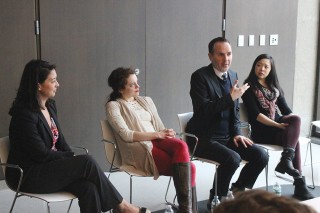Title

Three alums returned to Juilliard to share their experiences with the U.S. Immigration process with current international students. From left: Cory Owen, director of international advisement; Laura Careless (BFA, '07, dance); Clovis Nicolas (BM, '12, jazz bass); Kara Chan (BFA '15, dance).
(Photo by Jessica Liese)In February, three alums working in New York City came back to Juilliard to speak about their experiences with the U.S. immigration process in a panel moderated by Cory Owen, the director of international advisement. Dancers Laura Careless (BFA ’07), who’s from the U.K., and Kara Chan (BFA ’15), who’s Canadian, joined jazz bassist Clovis Nicolas (BM ’12), who’s from France, to answer current international students’ questions. Here are some of their tips.
Body
Keep great records. Artists applying for permission to work in the United States have to prove that they’re “extraordinary,” which generally entails providing evidence in the form of programs, news articles, posters, and the like. To ensure that the U.S. Citizenship and Immigration Service (U.S.C.I.S.) is sufficiently aware that you’re extraordinary, save everything you can, both actual and virtual, that demonstrates your value as a performer. Setting up a Google News Alert for yourself is an obvious first step, but have you set one up for every variation on your name— hyphens, nicknames, middle names, and etc?
Make the most of your OPT time. Before graduating from Juilliard, international students can apply for F-1 OPT (Optional Practical Training) status, meaning you can legally work in the United States for 12 months as long as the work relates to your field of study. This is an opportunity to obtain practical experience in your field as you prepare to find a sponsor for a more long-term work visa. Kara Chan, who’s in the midst of her OPT year, balances performance projects and teaching gigs with a hope of finding a visa sponsor.
Do your homework! Visa forms change all the time, and there are many pieces of information you’ll need to gather, so make sure you always have the most current forms and guidelines for whatever you’re applying for. You should also ensure you’ve researched all of your options and that you’re applying for the visa that best serves your needs.
You are your own best advocate. While you may have to enlist the help of an attorney to prepare your paperwork, don’t assume that the first attorney you meet will necessarily be the best one. For instance, some visa categories for artists are also used in other fields (science, for instance); thus, an immigration lawyer with experience in the type of visa you need may not necessarily have any idea about an artist’s specific requirements. It’s important to be familiar enough with your options and needs that you can have some input into your own applications. Laura Careless taught herself to prepare her own paperwork to save time and money, but she recommends using a competent lawyer for at least the first application.
Always be up-front about your situation. It’s up to you to make sure prospective employers know your immigration status before you’re hired—if it’s discovered that you were hired without the proper authorization, you could face severe immigration consequences!




